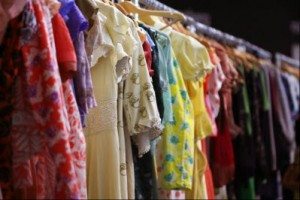 By Alanna Brown, LuxEco Editorial Assistant
By Alanna Brown, LuxEco Editorial Assistant
These days, any given suited politician, uniformed worker, outfitted student, or swaddled infant wears a garment no far cry from that of Iron Man. Synthesized and industrialized just like the incredible transforming suit, our clothing comes with all sorts of modern finishes. We purchase the wrinkle-free, stain resistant, flame retardant, anti-fungal, anti-bacterial, anti-static, odor-resistant, permanent-press, non-shrink fabric, smoothed-to-boot with softening agents. But the irony in this is that these resistant retardant protectants end up doing more harm than good. Every anti-fill-in-the-blank means more chemicals in your clothing.
A press release from O Ecotextiles states, “The textile industry has been condemned as being one of the world’s worst offenders in terms of pollution…” This is because the manufacture of textiles requires two important components: chemicals and water. This press release goes on to describe that, between dyes and transfer agents, there are as many as 2,000 different chemicals used in the process. Then there is the overuse of water, an already finite resource, being employed at every step; from helping transmit the chemicals, to washing them out in preparation for the next stage of production. “The water becomes full of chemical additives,” says O Ecotextiles, “and is then expelled as wastewater; which in turn pollutes the environment.” This toxic runoff wreaks havoc on our ecosystem, entering at unnaturally heightened temperatures, with an increased pH, and saturated with dyes, detergents, bleaches, brighteners, equalizers, and hundreds more. It doesn’t stop there though. The finished product, the clothing we wear, yet harbors many of these chemicals, which then evaporate into the air or become absorbed by the skin.
So what exactly is the danger of these chemicals? Let’s just begin with dyes. Exchangeforgreen.com enlightens us as to a few hazards found in the dying process alone: we find dioxin, a carcinogen and possible hormone disrupter; we find chrome, copper, and zinc, all known carcinogens; we find formaldehyde, a suspected carcinogen; and we find azo dyes group III A1 and A2, which give off carcinogenic amines. You may have noticed that all of these chemicals have a common thread…they are all carcinogenic. A carcinogen is any substance that is an agent directly involved in the exacerbation or spread of cancer. With our skin and lungs ever-vulnerable, this risk is not to be taken lightly. Exchangeforgreen.com says, “Once absorbed by humans, heavy metals tend to accumulate in the liver, kidney, bones, heart and brain. The effects on health can be significant when high levels of accumulation are reached. The effect is particularly serious in children due to effects on growth and their relatively low body mass.”
Getting even further to the root of the problem is the farming of textile crops like cotton. The Environmental Justice Foundation gives us several bulleted points about the fundamental chemical dangers of non-organic cotton production. For instance, cotton alone is to blame for the global implementation of 16% of insecticides—more than any other single crop. The article also talks about aldicarb. This chemical, “…a powerful nerve agent, is one of the most toxic pesticides applied to cotton worldwide. Despite its World Health Organization classification, ‘extremely hazardous’, 112 million dollars worth is applied to cotton crops each year.”
As for healthy alternatives, choosing natural fabrics made without dye is your best bet. There are even natively color-grown cottons, which come most commonly in shades of blue, green, brown, and purple. And when you do purchase cotton fabrics, choose organic. Organic cotton is a strong economic option, and is actually in high demand already. Katherine Hamnett, a leading fashion designer, says, “By insisting on organic cotton and fair pay for garment workers, and by paying 1% more for a t-shirt, you can change the world and make it a better and safer place.” There are also stores, both online and off, in which to make health-conscious clothing purchases. Fashion & Earth and Greenloop are just a couple sustainable style shops to get you started.













